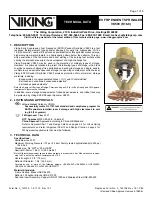
7
Ideally you want to play one of your most favourite pieces of music through the system that has rich
sounds and plenty of bass, being something you can identify with later when testing the helmet
installation.
Try to generate as much background noise as you possibly can by revving a bike engine or using a loud
TV, hi-fi system or perhaps a noisy vacuum cleaner etc, as this ambient noise will simulate helmet noise
as if riding.
With the system powered and the headset connected, plug the 3 pole end of the music lead supplied in the
kit into your music devices headset socket, and also connect the 4 pole end into Aux 4 socket of your hub.
Top Tips (2)
Make sure that you plug your music lead into the music systems headset socket and not the line out
socket, or the volume control may not work.
Adjust the music devices volume control to about half way and then press play. Listen to the music level
and adjust if required before holding the speakers over your ears.
Note that the speakers are
slightly off-set in their housings
so try to align the centre of the
speakers directly with centre of
your ear-holes (with the wire
coming out towards the back of
your head). Apply light pressure
to the back of the speakers and
you should now hear the music
clearly with the minimum amount
of background noise being heard.
You will notice that moving the
speakers just a small amount away
from your ears, or out of alignment
(up, down, backwards or forwards)
can easily half the volume and
reduce the sound quality, in
particular the bass response, and
let in considerable external
background noise which will spoil
the full potential of sound quality
and performance, especially at
higher speeds when the helmet
noise becomes far more powerful
and/or when using earplugs.
When you have readjusted the
speaker positioning comfortably
but firmly over your ears so that
the music quality is at its very
best and you can hear the least
amount of background noise
coming through,
you have found the best possible speaker position
and so you now know what
to aim for when fine tuning the speaker positioning after helmet installation.
If you now hold the microphone to your lips and project your voice positively through the loud spot, the
VOX turns your microphone on while at the same time automatically reduces the music level to improve
communications. When you stop speaking the microphones automatically switches off and the music
gently returns to its original level. Practice this a few times to become familiar with it, and show your
passenger what you have discovered.
Top Tips (3)
It’s sometimes a bit tricky holding three parts with only two hands so try pressing one ear to your
shoulder with the speaker in between, leaving your hands free for the other speaker and boom
microphone, or get someone to assist with holding the microphone for you.
SPEAKER POSITIONING
Top Tips (1)
Fine tune and perfect using the microphone loud-spot by listening to the sound of your voice through
the speakers while carefully moving the microphone around until it is at its very loudest point. It can
also help if you pucker your lips to the microphone as if kissing it.
Apart from providing you with audio confirmation of correct microphone and VOX use, side-tone also
helps you to naturally speak at the correct level when in noisy conditions and so also prevents
unnecessary shouting. However it is important not have your master volume control set
unnecessarily higher than needed, because apart from adding to riding fatigue and wasting valuable
battery power, if your side-tone level is set too loud it will make you want to speak much quieter
and so make it more difficult to operate a higher VOX setting, which may be needed for higher speed
use. Turning your master volume level as low as possible will reduced the level of your own side-
tone and encouraging you to speak louder and so make operating higher VOX levels much easier,
and save battery power.
If you are now comfortable with finding and using the microphone loud spot and operating the VOX
reliably without turning it lower than we have suggested, we want you to now experience the
importance of speaker positioning.
Centre of
speaker
Note that wire
normally comes out
towards back
Centre of ear hole
Centre of
ear hole
Centre of
speaker
Centre of ear
hole
Avoid speaker
near top of ear
Kit LIW Instructions.qxd 5/6/09 2:03 pm Page 7


































